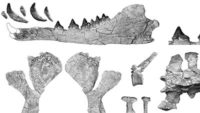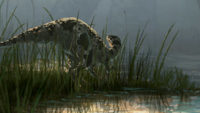How published geological reports help develop a biblical interpretation. Read More
By Troy Lacey A recent journal article features the discovery of a fossil (MUSM 3580) touted as a “walking whale,” in the Pisco Basin, located in the desert of Peru. …read more Source: AIG Daily
News reports reverberated with details from a fantastic new fossil site in southern China.1 The Cambrian remains supposedly represent some of the earliest creatures to have evolved on Earth, but two telling details show why these fossils fit better with biblical creation. Researchers described in the journal Science the unique set of animals buried in black Cambrian siltstone l… More… …read more Source: icr.org
Can opals and opalised fossils form quickly under the right conditions? …read more Source: creation.com
By Ken Ham After examining a fossil left in a box in storage for ten years, scientists made a surprising discovery—this fossilized bird, found in lower Cretaceous sediment, was preserved with her unlaid egg still inside her. There was also evidence of medullary bone, “a calcium-bearing tissue that aids in eggshell formation.”1 This is strong support for the idea that so-called ancient birds (this one dated at a supposed 110 million years) created and laid eggs in a similar fashion to today’s birds. The scientific paper on this find, published in Nature Communications, is unequivocally reporting on a true …read [More]
By Dr. Marcus Ross In all the hoopla about the really big dinosaurs, the little ones get forgotten. …read more Source: AIG Daily
By Troy Lacey Paleontologists working in the Jinju Formation (Early to Mid-Cretaceous) in southeast South Korea discovered ten well-preserved spider specimens in shale. …read more Source: AIG Daily
The erosion that occurred during the latter stages of Noah’s Flood is almost unimaginable, but remarkably obvious. …read more Source: creation.com
By Dr. Marcus Ross Contrary to popular portrayals of T. Rex as an ungainly brute who lumbered onto the scene millions of years ago, he was regally designed. …read more Source: AIG Daily
By Ken Ham A recent article from Live Science reports on new reconstructions at the American Museum of Natural History in New York City that claim to be “the most accurate models of [T. Rex] to date.” And this new reconstruction features baby T. Rex as a turkey-sized ball of fluffy feathers. But did T. Rex and other dinosaurs feature a covering of feathers? Today’s narrative is that birds are really dinosaurs, an idea supposedly supported by so-called feathered dinosaurs. Evolutionists increasingly cover nearly every dinosaur species in fluffy feathers. Today’s narrative is that birds are really dinosaurs, an idea [More]
Below the sea around land masses there is evidence of rapid water run-off, not slow and gradual erosion. …read more Source: creation.com
Descriptions of feathered dinosaurs continue to wing their way into scientific literature. While most researchers see each new example as another link in a Darwinian story of reptiles somehow evolving into birds, others fit these fossils into more classical categories. Two new discoveries give owners of these opposing views new opportunities to peck at each other’s ideas of bird beginnings. Both cases are easy to land on a creation-friendly… More… …read more Source: icr.org
When did they form and how? …read more Source: creation.com
Within months, a river was so drastically changed that many could not believe what they were seeing. …read more Source: creation.com
Discovering fossil spiders has become fairly common.1 Each time they have been 100% spiders, not vague evolutionary ancestors with partial or transitional features.2 Now a whole collection of “ancient” spiders from the Cretaceous (Albian) Jinji Formation in Korea has been discovered.3 This is a significant discovery because these small arachnids were found to have a special eye mem… More… …read more Source: icr.org
If most coal was formed from plants other than lycopods, then do we need the floating forest hypothesis to explain the origin of coal? …read more Source: creation.com
The last time I checked, sharks didn’t swim on land. Most shark species inhabit saltwater oceans. Maybe tyrannosaurs swam some, but they didn’t dwell in oceans. Yet somehow sharks and tyrannosaurs died and were buried together. This curious combination calls for a big rethink on an issue that a new study just made bigger. More… …read more Source: icr.org
Can happen faster than secular scientists think. …read more Source: creation.com
By Troy Lacey Two amber fossil finds have revealed some interesting examples of similarities between fossil and extant forms, both in morphology and in lifestyle/behavior. …read more Source: AIG Daily
By Heather Brinson Bruce Do fossils require millions of years to form? Hardly! Even secular geologists now recognize that rocks form very quickly. …read more Source: AIG Daily
Secular science believes Earth’s oceans have existed for about four billion years.1 They also think the level of the ocean has remained about the same over that vast period of time. However, a new study published in Nature creates serious problems for the uniformitarian origin of our oceans and their long-term sustainability.2 Chen Cai and his colleagues from Washington University … More… …read more Source: icr.org
How did this fascinating tourist feature form? …read more Source: creation.com
By Ken Ham A recent editorial reminded me of the secular claim that diamonds take billions of years to form. Is that true? …read more Source: AIG Daily
Archaeopteryx is a big word that simply means “ancient wing.” It refers to a set of fossils of a strange-looking extinct bird. Books promoting evolution often show pictures of Archaeopteryx. Its beak had small teeth, so many scientists see it as playing a lead role in an unthinkably long plot about reptiles evolving into birds. Others admit it was just a bird. New research places Archaeopteryx more firmly in the bird category than ever before. Read More: Does Archaeopteryx Show Bird Evolution? | The Institute for Creation Research
A Polish research duo described the remains of an elephant-size synapsid from upper Triassic rocks. Only it’s not supposed to be there. Secular reactions express shock at this turn from a longstanding evolutionary tale. Synapsids are commonly referred to as “mammal-like reptiles,” but were neither reptiles nor mammals. They were unique—the sail-finned dimetrodon was a synapsid. Like dinosaurs, … More… …read more Source: icr.org
Large natural bridges and freestanding rock arches are structures left behind after erosive action, features called erosional remnants. Along with several other types of landforms examined in this magazine in recent years, they provide further evidence for rapid erosion in the late stages of Noah’s Flood. Read More: The puzzle of large natural bridges and freestanding arches – creation.com
Response to a correspondent who had taken a CMI writer to task, claiming that 14C, dendrochronology, and uranium-thorium (U-Th) dating techniques are trustworthy. …read more Source: <a href=http://creation.com/carbon-dating-fooling-who target=_blank title="Carbon dating-who is fooling who?” >creation.com










































